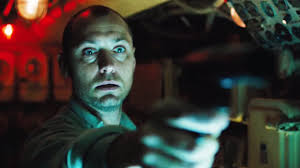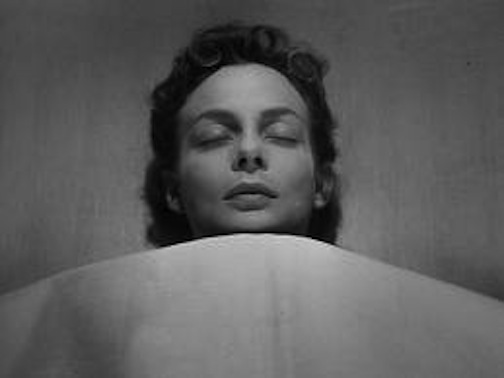Rystetur means Rigor: The Films of Carl Theodor Dreyer
 Thursday, February 9, 2012 at 08:22PM
Thursday, February 9, 2012 at 08:22PM 
"No matter where he directed – France, Germany, Norway, Sweden – he found himself in constant conflict with producers and backers. They regarded him as an obstinate artist, and a costly one, because of his fanatical attention to detail and atmosphere."
Ephraim Katz
The Film Encyclopedia
Elements of a Director’s Style: Carl Theodor Dreyer
1) Subject Matter
a) How our emotions serve as the doorway to spirituality.
b) How morality is reflected in physical character; body is spirit.
c) The endurance of injustice and self-delusion in the face of the Divine.
d) The cultural details of the era of his stories.
e) Life's persistent quality of transcendence.
"Nothing in the world can be compared to the human face. It is a land one can never tire of exploring. There is no greater experience in a studio than to witness the expression of a sensitive face under the mysterious power of inspiration. To see it animated from inside, and turning into poetry."
Carl Theodor Dreyer
Thoughts on My Craft
2) Script:
Dreyer began his working life as a barroom pianist. His most substantial money earning came from his work as a court reporter. Both jobs influenced him greatly: the role of art in sanctifying the profane, and the transcendence available through (deceptively) simple, rigorous re-creation of life. He made only fourteen films in fifty-three years. At issue was money, Nazi repression, audience & critical scorn, money…but Dreyer never took on a project half-assed. If he needed five years to sort out his visual sense of story, then five years it was. Few filmmakers have so married visual narrative to emotional narrative, and few have been able to so scrap 'story' narrative for the emotional. By depicting every quark of every feeling experienced by his characters, Dreyer lets the 'story' unfold through the expression of his characters' emotions. This is, obviously, backwards from almost every other filmmaker. Most let the events of the narrative serve as the engine of their characters' emotions. (For example, Keanu experiences distress because there's a bomb on the bus.) While that should make Dreyer's films opaque, they are instead, luminous. His characters’ emotions are never unclear, and neither is the sequence of narrative events.
" His greatness lies in making tranquil pictures of overwhelming feeling. The sanctity of emotions is his faith and the cinematic ability to make an aesthetic and ordered narrative is his aim."
David Thomson
The Biographical Dictionary of Film

3) Images - Composition and Lighting
Known, rightfully, as the master of the close-up, Dryer's images are simple, uncluttered, direct, packed with narrative information and somehow filled with space that contextualizes the people or events each shot contains. His style alters not from film to film, but from period to period; his earlier silent films (and Vampyr is on the cusp between his sound and silent work) harken visually to his idol, D. W. Griffith. But Dreyer relied less on the American style of hurly-burly, hyper-active frames and more on a European, painterly understanding of how each element within a composition could wield spiritual, emotional and narrative power. The stateliness of his framing, the intensity of his compositions and the transcendent effects of his images, have earned him a kind of Film Society-only rep, the great filmmaker whose films should be worshipped but are too boring to be enjoyed. If you've never seen a Dreyer film, Joan of Arc will dispel that notion in the first five minutes.
Whether Dreyer utilizes close-ups or weird tracking wide shots, the weight of his purposefulness palpably fuels his camerawork and composition: you will know and understand the emotional valence of a shot instantly, and that knowledge (and the feeling it provokes) will grow as the shot is held. His direct, recognizable purposefulness does not obscure the transcendent quality of his images. That manifest directorial will only makes the sense of divinity and awe grow. When you figure out how he accomplishes this, please let me know.
"What interests me is reproducing the feelings of the characters in my films. The important thing is not only to catch hold of the words they say, but also the thoughts behind the words. These are the expressions of the depth of the soul."
Carl Theodor Dreyer
Thoughts on My Craft
4) Acting Performances
Dreyer’s actors are usually amateurs, chosen for their faces. Director Eric Rohmer, who calls Dreyer one of his 'dream masters,' echoed Dreyer's casting technique: he found actors whose faces bore a key quality he wanted his characters to manifest. Or, if not amateurs, Dreyer's actors might be avatars in other realms, like the poet and playwright Antonin Artaud, who plays a tormented priest in The Passion of Joan of Arc. Dreyer ran his actors through a million takes; he almost killed poor Maria Falconetti, who plays Joan. Dreyer's insistence on capturing the most minute emotional truth, his willingness to shoot and shoot and shoot, his imperious and often obscure direction over eighteen months of shooting…all this lead Falconetti to never act again.
5) Pace, Cadence and Rhythm
Dreyer's films always seem – in the first couple minutes – like they're going to take a long time to get to the point. But, unlike fellow Transcendent Robert Bresson, Dreyer never makes a story longer than it needs to be; Joan of Arc is shockingly compact. The intensity of each shot might make the pace seem slower than it really is. When a Dreyer film ends you're left still wishing it would go on, if for no other reason than to give you time to digest all you've felt. Dreyer paces to his own rhythm, and he's not compelled by separate acts or theatrical structure. He gives each scene the weight he thinks it warrants for its precise place in the (emotional) narrative and then moves on. A crucial scene might last for one close-up or it might take ten minutes.
"Throughout Dreyer's films and his writings about films there runs a consistent thread of ambiguity: whether art should express The Transcendent or the person (fictional character or film-maker) who experiences The Transcendent: whether Transcendence is an inner or outer reality."
Paul Schrader
Transcendental Style in Film: Ozu, Bresson & Dreyer
6) Editing
Because Dreyer is famed for the power of his close-ups, you might think he structures his films primarily though cutting. He maintains that his editing is almost incidental, and that each shot so holds its own narrative purpose that it need not be juxtaposed against another to have its full effect (Kubrick and Tarkovsky operates similarly). I'm not so sure I believe it. Such a position is purposefully antagonistic to the classic Eisensteinian position that a shot’s meaning derives solely from its juxtaposition to other shots. Eisenstein held that an effective sequence of shots produces an effect greater than the sum of its parts. Dreyer cuts as if each shot was a film/painting/novel/universe unto itself. He has a knack of Eisensteinian reduction in action sequences – he eliminates every unnecessary visual moment to build sequences of great rhythm and narrative drive.
" Dreyer demonstrates triumphantly that the close-up was not just a means, but an end."
David Thomson
The Biographical Dictionary of Film
7) Use of supportive elements: design, costumes, music, etc.
Dreyer, like Rohmer after him, lets the costumes speak volumes about power, class, aspiration and social place. Each character is understood and known visually, and that knowledge comes from his or her dress. Yet, treading adroitly on the blurred line between reality/un, Dreyer places these almost realist figures in an almost purely expressionistic space. Deeply influenced (during this era of his career, at least) by German Expressionism, Dreyer's sets are never quite as real, as symmetrical, as naturalist as his costumes. He likes his wholly real figures to move in a world that is bent just enough to express not physical, but emotional reality. And the universe of soul and spirit lurking behind and occasionally expressed by that emotion.
 Bresson,
Bresson,  Dreyer,
Dreyer,  Passion of Joan of Arc,
Passion of Joan of Arc,  Paul Schrader,
Paul Schrader,  Rohmer
Rohmer 






